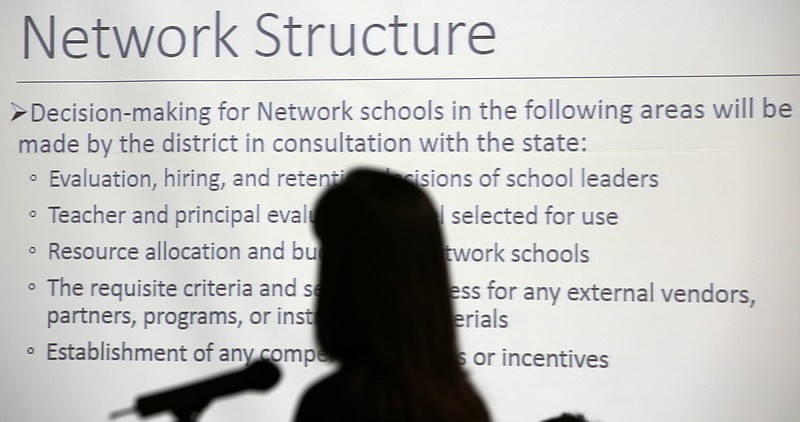'Partnership Network' schools
Brainerd High SchoolDalewood Middle SchoolOrchard Knob ElementaryOrchard Knob Middle SchoolWoodmore Elementary
The state of Tennessee's latest plan for Hamilton County's lowest-performing schools, which does not include a state takeover of the five worst schools, was met with enthusiasm at a school board work session Thursday night.
State Education Commissioner Candice McQueen, who has visited the area several times in the past few weeks, presented the newest plan for the five schools previously known as the iZone schools. It includes a memorandum of understanding and the formation of a "Partnership Network."
The network leaves responsibility for the schools - Brainerd High, Dalewood Middle, Orchard Knob Elementary, Orchard Knob Middle and Woodmore Elementary - to the district. It would include the formation of a 7-person advisory council, a state-funded partnership liaison to traverse the relationship and strategic funding.
This plan has evolved since the state first threatened to take over the schools, which have shown up on the state's priority school list of the bottom 5 percent of schools for two cycles, in the fall of 2016.
Timeline
› 2001: The state identifies 11 Hamilton County schools as “in need of improvement.” The list includes Dalewood Middle, Orchard Knob Middle, Orchard Knob Elementary and Woodmore Elementary.› 2012: The Tennessee Department of Education identifies the bottom 5 percent of schools statewide. The state terms the schools “priority schools” and the list includes Brainerd High, Dalewood Middle, Orchard Knob Middle, Orchard Knob Elementary, Woodmore Elementary and Chattanooga Girls Leadership Academy.› Spring 2013: Hamilton County Schools receives a three-year School Improvement Grant to support its five priority schools, also known as iZone schools — Brainerd High, Dalewood Middle, Orchard Knob Middle, Orchard Knob Elementary and Woodmore Elementary — totaling more than $10 million.› Fall 2013: Chattanooga Girls Leadership Academy receives honors for strong academic improvement and moves off the state’s priority schools list. The other five Hamilton County Schools remain on the list.› January 2016: The state sends a report to Hamilton County Schools notifying leaders the district’s five iZone schools are not making expected progress, placing blame squarely on the district’s leadership.› Fall 2016: The state threatens to take over at least some of Hamilton County’s iZone schools if academic gains are not made.› Spring 2017: The state proposes working with Hamilton County Schools through a “Partnership Zone” to support the five iZone schools as an alternative to takeover.› Summer 2017: The Hamilton County Board of Education hires Superintendent Bryan Johnson and he asks for more time to talk to the state about plans for the five schools.› Fall 2017: Superintendent Johnson launches the Opportunity Zone, which encompasses the five schools and their feeder systems, a total of 12 schools, to provide more specific supports. The board votes 7-2 to continue discussing a partnership with the state.› January 2018: The state proposes a new plan — a network that would leave governance of the schools to the district and would establish an advisory board and liaison between the state and the district.Sources: Tennessee Department of Education, Times Free Press archives
"These schools have been in need of improvement for many years, for more than a decade, and so the work we were doing with the district a year ago was really to think about a different type of governance structure or to take them over completely, because we didn't see the pace of change occurring with students that we wanted to," McQueen said.
The state's confidence in the new plan is rooted by and large in its confidence in Hamilton County's new Superintendent Bryan Johnson, who took the helm last summer and launched the vision for the Opportunity Zone - which is made up of 12 total schools in the Brainerd High and Howard School feeder systems.
"The reality is a lot has been happening in Hamilton County over the last six months; some of that is bringing in new leadership from Dr. Johnson and through the entire central office, but also making some structural shifts to what the iZone did look like and what the Opportunity Zone now does," McQueen said.
Since he launched the Opportunity Zone, Johnson appointed an executive director, Jill Levine, to oversee the schools. He also reallocated more than $1 million to form a leadership team specific to the zone that includes a range of positions from curriculum specialists to community school and recruitment coordinators.
"I feel that we've seen a shift in the district under Dr. Johnson's leadership," said board Vice Chairman Karitsa Mosley Jones of District 5, which contains several of the Opportunity Zone schools.
Levine, who will remain responsible for the schools according to the agreement, echoed that sentiment earlier in the day when McQueen and her staff visited Orchard Knob Elementary School.
"We're really excited with what Dr. Johnson has done and with this big investment in the schools," Levine said. "We are seeing unprecedented support, and I think we are at the cusp of change."
The state hopes the board will vote on the memorandum at its next meeting on Feb. 15. The network's organization will spring from that date, as the draft agreement requires the new advisory council members to be chosen within 30 days of signing the agreement. Hamilton County, under Johnson's leadership, will appoint three of the advisory board members and the state will appoint the four others.
One of the few comments from board members at the work session about the agreement came from District 1 school board representative Rhonda Thurman in regard to who is appointed to the unpaid advisory board.
"I want to be very careful," she said. "There's going to be some other organizations who are going to try and put their people through, and we want people from the community who really have a heart for these kids."
"We need some new blood, that's what I am going to suggest we do," she added.
Though neither the state nor the district have named or suggested specific individuals, both Johnson and McQueen reiterated that advisory board members must have the passion - and the time - available for the commitment.
Once the board is named and the liaison hired, they will have 60 days to draft specific goals for the network.
The required goals outlined in the agreement include:
Increases in the number of students scoring on grade level or mastering the TNReady assessment.
Increases in the number of students deemed Ready Graduates as outlined in the state accountability model.
Decreases in chronic absenteeism.
Schoolwide growth scores that exceed expectations, at a level four or five.
Increases in the hiring and retention of highly effective educators.
Placement and retention of highly effective leaders in each school.
Though finance is one of the main sections of the draft agreement, the partnership network's main focus is not centered around extra funds provided for the schools.
"Quite frankly, that is what was not going well with the iZone, when we said 'Here are the funds and you just tell us what you're going to do with them,'" McQueen said.
In 2013, the district received about $10 million in state school improvement funds, but progress in the priority schools did not follow. Instead, the state is planning on working with the district to strategically allocate existing funds as well as state funds to the needs of the district.
The state anticipates about $1.6 million - $600,000 from the state's school improvement fund and another $1 million in federal funding - to be allocated to the partnership network, but McQueen emphasized that through the partnership the department will help the district recognize or locate other available funds.
"We are trying to be more strategic and thinking strategically with where those funds are going," added state department of education Chief of Staff Laura Encalade.
The new partnership also does not require law to change - a concern many had with the previously proposed zone. Since the network does not change governance of the schools, only a memorandum of understanding is needed. The legislation the department drafted when the previous iteration of the Partnership Zone was under consideration is not needed and the department has abandoned it, according to McQueen.
If the board accepts the agreement next Thursday, the Partnership Network will officially go into effect for the 2018-2019 school year and remain intact for five years.
Contact Meghan Mangrum at mmangrum@timesfreepress.com or 423-757-6592. Follow her on Twitter @memangrum.

